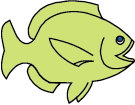

Goals:
2.Ý To create coral, see how it forms and find out why it is so vulnerable to the human touch.
3.Ý To make students aware that the formation of coral takes many years and many resources from the earth.
4.Ý Work effectively with other students to complete the work.
5.Ý Students will observe the growth of crystals that develop in a way similar to how coral polyps create their calcium carbonate cups.
6.Ý To familiarize students with the conditions coral reefs need in order to survive.
Materials:
Information on coral reefs and their formations. (For example: Sea World and Busch Gardens web site at: http://www.seaworld.org/coral%5Freefs/coralcr.html)
Computer database and Internet access
A detailed map of the location of the major bands of coral reefs around the world.
Time:
Materials:
Pieces of charcoal, porous brick, tile, cement, or sponge
Water
Table salt (iodized or plain)
Liquid bluing (found by the bleaches in the grocery store)
Food coloring
Measuring spoons
Masking tape
PensÝ
Procedure:
2.Ý Students should pour two tablespoons of water, two tablespoons of salt, and two tablespoons of liquid bluing over the base material (charcoal, etc.). Set bowls on a table or counter top. Formations need free air circulation to develop.
3.Ý The next day have them add two more tablespoons of salt.
4.Ý On the third day, pour in the bottom of the bowl (not directly on the base material) two tablespoons each of salt, water, and bluing. Then add a few drops of food coloring to each piece of base material.
5.Ý A crystal formation should appear by the third day. If not, it may be necessary to add two tablespoons of household ammonia to aid the growth. (Only teachers or other adults should handle the ammonia). To keep your formation growing, just add more liquid bluing, salt, and water from time to time.
6.Ý Explain to the students that just as the water, liquid bluing and dissolved salt combine to form crystals. Coral polyps use dissolved calcium carbonate to create the stony cup that protects their soft bodies and creates reefs.
7.Ý Each day observe the coral formation and discuss how it is forming as well as what it looks like. Consider this as a possible journal topic in Science class and have the students read what they wrote to the entire class.
Note: You must follow all these steps correctly. No adaptations or modifications can be made.
Materials:
copy of score card
Procedure:
2.Ý Explain to the students that they will be playing a game that involves each student to roll the die three times, once for every survival factor (listed above). The students will pretend that they are a piece of coral.
3.Ý In order to survive they must roll one of the following numbers:
4.Ý Make the score sheet visible so the students can keep track of how well they are doing.
5.Ý Have the students come up one at a time to roll the dice. Explain what factor they are rolling for. If they roll a good number they move on to the next round.
6.Ý The finalist will be brought up to the front of the class. They will be asked these final questions:
The students that answer the question correctly are the winning coral reefs.
Materials:
Large sheet of paper
Markers, crayons, colored pencils
Procedure:
2.Ý Have the students construct a full scale map of the world labeling the continents, oceans, and some of the major seas located around the world. Have the students make this very colorful and exciting!
3.Ý From the information that they learned, have the students guess where they think some of the major coral reefs ranges are in the world. Have them come up to the map and draw them in.
4.Ý Provide the students with information that includes the exact location of coral reef ranges in the world. Have the students come up to the map and put the location of the reefs on the map.
5.Ý If you can, provide the students with a sample of coral reefs so they can actually feel and see what it looks like.
Assessment:
2.Ý Have a private interview with the student to see how much he or she learned when doing this. (Criteria for success = From questions and through the conversation of the students, the teacher will give the student points towards their knowledge. This could count for an assignment or for bonus points).
Curricular Strands and Major Concepts:
2.Ý Science- Exploring the formation of coral reefs and how this formation effects the environment.
3.Ý Math- Using the teaspoon measurement to measure out the necessary component needed to form the coral reef. Probability could be used to see how many times a student would get a certain number on the die.
4.Ý Social Studies- Geography of the world and map reading.
Possible Extensions:
2.Ý Create a tropical rain forest out of an aquarium. Put everything in the rain forest that would actually be in it. Cover the top with plastic to create the moisture needed in a rain forest. Watch the plants grow and become mature.
Resource:
Back to Table of Contents
Coral Reefs - developed by Kristen Treadway, Jenny Mavis, T. J. Beck, & Jim O'Keefe
This page submitted by the St.
Norbert College Ocean Voyager Program
Ý
Ý